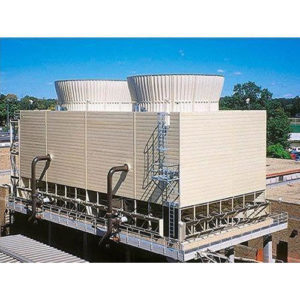Chemically Treated Cooling Towers:
Chemically treated cooling towers water treatment, a cooling chemically and water system can suffer from scale formation, corrosion and fouling and may become a breeding ground for harmful bacteria such as those which cause Legionnaires’ Disease. This reduces efficiency, shortens plant life and makes your operation unreliable and unsafe. Poor control can not only put your cooling process at risk, but can also squander in wasted energy, chemicals and water charges. To overcome these problems we’ve developed a comprehensive range of chemically treated cooling towers are water treatment products and services to keep your system operating safely and efficiently.
Image:

Process:
Chemically treated cooling towers are calculate and understand your “cycles of concentration.” Check the ratio of conductivity of blow down and make-up water. Work with your cooling tower water treatment specialist to maximize the cycles of concentration. Many systems operate at two to four cycles of concentration, while six cycles or more may be possible. Increasing cycles from three to six reduces the chemically treated cooling tower make-up water by 20% and cooling tower blow down by 50%. The actual number of cycles you can carry depend on your make-up water quality and cooling tower water treatment regimen. Depending on your make-up water, treatment programs may include corrosion and scaling inhibitors along with biological fouling inhibitors. Install a conductivity controller to automatically control blow down. Working with your water treatment specialist, determine the maximum cycles of concentration you can safely achieve and the resulting conductivity (typically measured as micro Siemens per centimeter, us/cm). A conductivity controller can continuously measure the conductivity of the cooling tower water and discharge water only when the conductivity set point is exceeded.
Major Component:
- The Evaporator – Typically compresses a gas to allow a heat transfer from one part of the system to another. This part of the system does not require water treatment.
- The Chilled Loop – Picks up heat at a source (i.e. air handler for incoming air into a building), transfers that heat via the evaporator.
- Open Loop – Open to the atmosphere; contains the Cooling Tower. Heat is transferred outside the building, back into the atmosphere.
Major Chemicals:
- Corrosion –
Anytime water and metal come in contact, there is going to be corrosion. How well the water treatment professional minimizes that corrosion is a measure of the water treatment program’s success. - Fouling –
The effect of airborne contaminants (airborne dust, dirt) that are subjected to the system by movement of the air through the water and to a lesser degree by particles falling directly into the tower (leaves, bird droppings). - Microbiological Contaminants –
A layer of dead or alive microbiological growths (algae, fungi, yeasts, melds, and bacteria) that can cause corrosion, lead to increased scaling, provide a means to trap foul ant materials and can cause excessive energy consumption if they build films on the heat exchange components. A micro bio film of 1/64″ can cause up to a 30% increase in electrical demand.
Advantages:
- Protection against bio films and
- Pathogens that can lead to Legionnaire’s disease
- Production time
- Equipment life
- Water, chemical & energy usage

